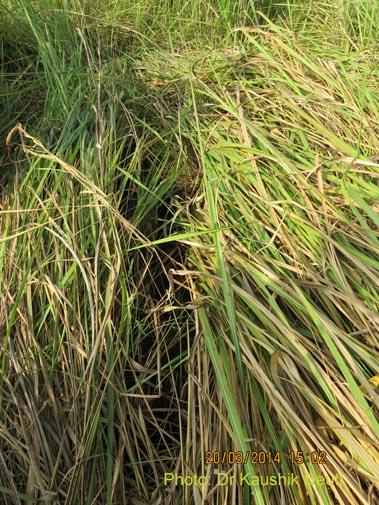The conservation community in Assam have now several reasons to cheer. A survey for grassland species was recently conducted from 18th to 22nd March, 2014 at Manas National Park. The specific targets of this collaborative survey have been the highly endangered Pygmy hog (Porcula salvania) and Hispid hare (Caprolagus hispidus) for which Manas is known as the last remaining wild habitat in the world.
The survey team led by the forest department included individual grassland experts such as Dr Bibhuti Lahkar from Aaranyak, Dr Gitanjali Banerji from Zoological Society of London, and Dr Kaushik Deuti from Zoological Survey of India and several researchers and PhD students currently working in Manas. A total of 17 camp sites under prime grassland habitat were surveyed under two ranges of Bansbari and Bhuyanpara respectively. GPS-based Sign survey method was used to look for indirect signs such as pygmy hog droppings, nests and hispid hare pellets and feeding signs. A total of 20 nests of Pygmy hog were detected from three separate locations. Hispid hare pellets were found almost on all camp site locations. Besides, direct evidence was also obtained for other grassland obligate species such as hog deer (Hyelaphus porcinus), swamp deer (Rucervus duvaucelii), and Bengal florican (Houbaropsis bengalensis) .
Field Director, Manas Tiger Reserve, Shri Anindya Swargowary has welcomed the preliminary results obtained especially for Pygmy hog which were thought to be declining in number at the Park. With this result, Manas is back on track as one of the last stronghold for these endangered species in the wild. He stated that the population of all the grassland species will need to be periodically monitored and the forest staff will be trained to monitor the same using indirect signs such as nests and droppings.
Dr Bibhuti Lahkar welcomed the initiative by the department in conducting this survey and stated that wet alluvial grasslands dominated by Barenga (Saccharum narenga), Ulu ( Imperata cylindrica) species under the two ranges were critical for survival of Pygmy hog and hence must be protected by taking suitable measures such as early mosaic burning and systematic removal of anthropogenic pressure such as grazing and the spread of invasive species.











Add new comment